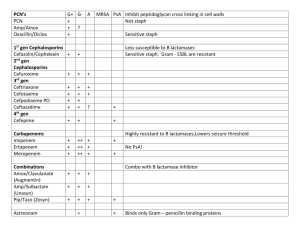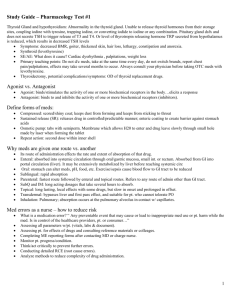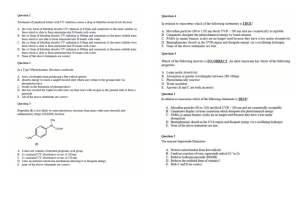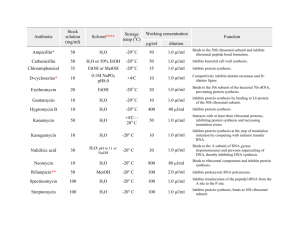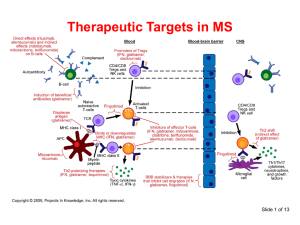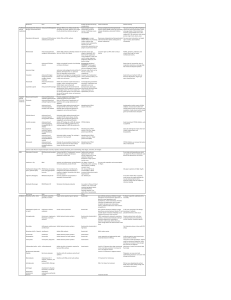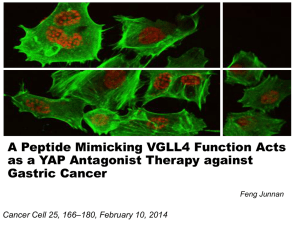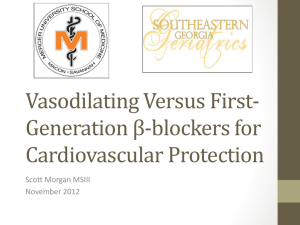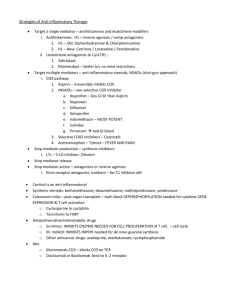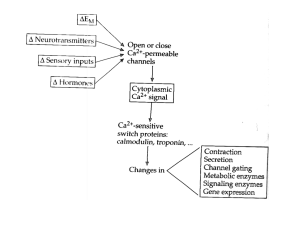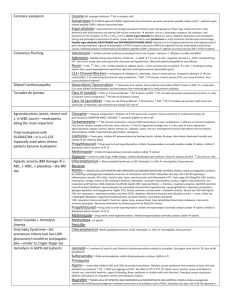Drugs - UTCOMClass2015
advertisement
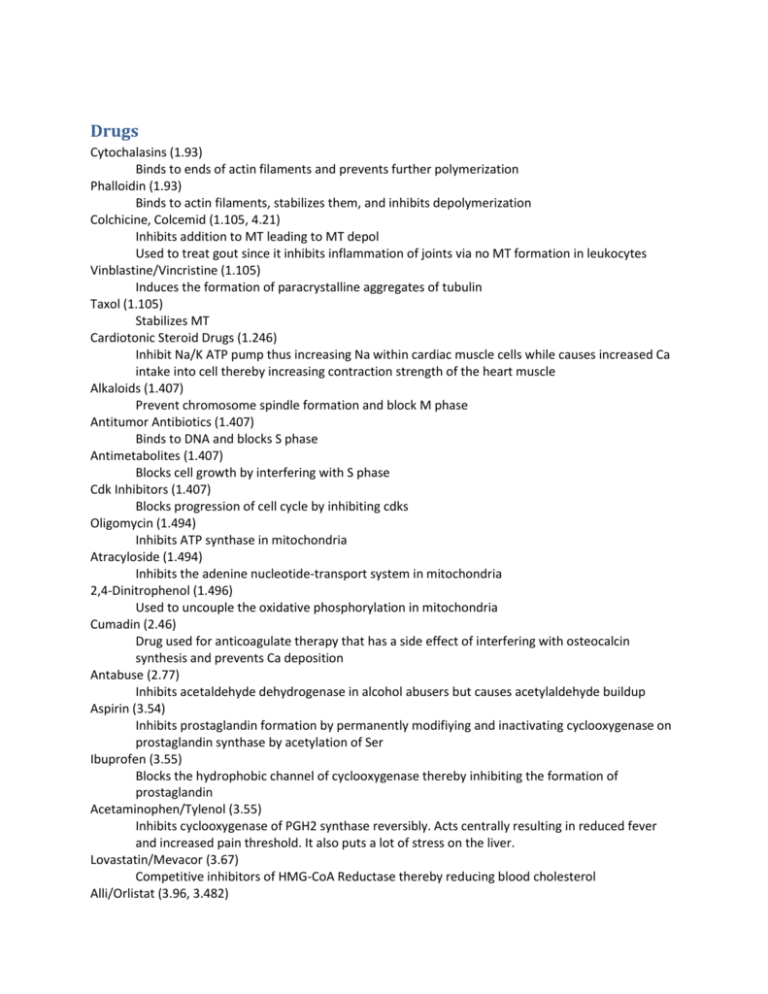
Drugs Cytochalasins (1.93) Binds to ends of actin filaments and prevents further polymerization Phalloidin (1.93) Binds to actin filaments, stabilizes them, and inhibits depolymerization Colchicine, Colcemid (1.105, 4.21) Inhibits addition to MT leading to MT depol Used to treat gout since it inhibits inflammation of joints via no MT formation in leukocytes Vinblastine/Vincristine (1.105) Induces the formation of paracrystalline aggregates of tubulin Taxol (1.105) Stabilizes MT Cardiotonic Steroid Drugs (1.246) Inhibit Na/K ATP pump thus increasing Na within cardiac muscle cells while causes increased Ca intake into cell thereby increasing contraction strength of the heart muscle Alkaloids (1.407) Prevent chromosome spindle formation and block M phase Antitumor Antibiotics (1.407) Binds to DNA and blocks S phase Antimetabolites (1.407) Blocks cell growth by interfering with S phase Cdk Inhibitors (1.407) Blocks progression of cell cycle by inhibiting cdks Oligomycin (1.494) Inhibits ATP synthase in mitochondria Atracyloside (1.494) Inhibits the adenine nucleotide-transport system in mitochondria 2,4-Dinitrophenol (1.496) Used to uncouple the oxidative phosphorylation in mitochondria Cumadin (2.46) Drug used for anticoagulate therapy that has a side effect of interfering with osteocalcin synthesis and prevents Ca deposition Antabuse (2.77) Inhibits acetaldehyde dehydrogenase in alcohol abusers but causes acetylaldehyde buildup Aspirin (3.54) Inhibits prostaglandin formation by permanently modifiying and inactivating cyclooxygenase on prostaglandin synthase by acetylation of Ser Ibuprofen (3.55) Blocks the hydrophobic channel of cyclooxygenase thereby inhibiting the formation of prostaglandin Acetaminophen/Tylenol (3.55) Inhibits cyclooxygenase of PGH2 synthase reversibly. Acts centrally resulting in reduced fever and increased pain threshold. It also puts a lot of stress on the liver. Lovastatin/Mevacor (3.67) Competitive inhibitors of HMG-CoA Reductase thereby reducing blood cholesterol Alli/Orlistat (3.96, 3.482) It inhibits pancreatic lipase which causes TGs to go unabsorbed. Causes intestinal problems and patient becomes averse to fat and usually results in modest weight loss only. Benecol (3.97) Plant sterols that inhibit uptake of cholesterol into micelles and inhibit intestinal cholesterol esterase Zetia (3.97) Inhibits enterocyte cholesterol transporter – NPC1L1 Cholestyramine/Colestipol (3.97) Resins that bind bile acids that reduce body’s recycling of bile resulting in more cholesterol being used for bile synthesis Niacin (3.314) It reduces LDL and TG while increasing HDL by decreasing lipoprotein synthesis and VLDL production and decreasing unesterified FA mobilization Fibrate (3.315) It decreases TG and increases HDL by antagonizing a transcription factor for genes for lipid metabolism. May increase non-CHD morbidity Statin (3.316) Decrease LDL and TG whilst increasing HDL and results in many other anti-atheroscleric effects TZD Class Drugs (3.573, 3.630) They act as a ligand to activate PPAR thereby causing adipocyte gene expression. They also help in regulating blood glucose. Sulfonylurea agents (Glyburide) (3.628) Bind to sulfonylurea receptors inhibiting the K channel causing increased pancreatic insulin secretion Meglitinides (Repaglinide) (3.628) Same as Sulfonylurea agents Biguanides (Metformin) (3.629) Decrease hepatic gluconeogenesis and helps up-regulate insulin targets Allopurinol (4.22) Used to treat gout by acting as a suicide inhibitor for xanthine oxidase Uricosuric Drugs (4.22) Increases renal clearance of uric acid by inhibiting reabsorption Glutamine analogs (Azaserine) (4.25) Inhibits anything using glutamine in purine and pyrimidine synthesis Purine Nucleotide Analogs (4.25) Inhibits PRPP amidotransferase and is used to treat acute leukemia 5-fluorouracil (4.32) Inhibits thymidylate synthesis by inactivating it Intercalating agents Ethidium bromide (4.160) Binds between the bases and into the minor groove as an intercalator Bisdaunomycin (4.161) Intercalates into DNA and uses benzene groups to interact with minor groove Actinomycin D (4.162, 4.280) Intercalates b/w G’s and C’s Blocks RNA Pol progression Minor Groove agents (4.162) Netropsin, Mitomycin C DNA crosslinkers (4.165) Platinum based drugs link the two strands together to fight cancer Acycloguanosine/Acyclovir (4.196) Causes chain termination when incorporated into viral DNA infections Cytosine Arabinoside (4.196) Inhibits topoisomerase 1 Azido-thymidine/AZT (4.196) Incorporation into DNA results in chain termination. Used against AIDS Sulfonamide Drugs (4.265) Inhibit a step in folic acid synthesis Rifampicin (4.280) Binds to beat subunit of prokaryotic RNA polymerase. Used to treat TB Alpha-Amanitin (4.280) Inhibits eukaryotic RNA Pol 2 and 3 Tamoxifen (4.290) Binds to estrogen binding region and recruits co-repressors that suppress gene activity Diphtheria Toxin (4.318) Inactivates EF2 within a cell preventing all protein translation and eventual cell death
